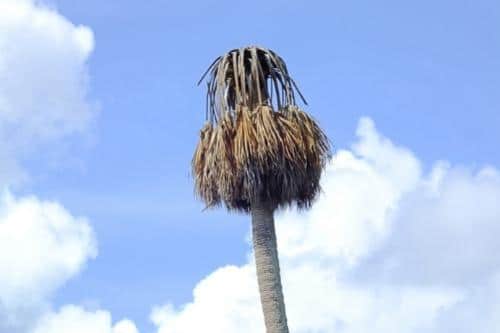If you have a palm tree that is looking sick, you might be wondering if it is even still alive.
Some key indicators that your palm tree has not survived include young fronds falling off, leaf discoloration and death, and wilted fronds. If the central area at the top of your palm tree has gone brown, the tree is dead.
Understanding whether a palm tree is still alive or not will help you determine when and if you need to remove and replace a tree. In this article, we’re going to look at the top indicators that your palm tree has not survived.
How Do I Know If My Palm Tree Has Died?
There are quite a few things that will tell you if your palm tree has died. Some of these are clearer than others, so use all of the below indicators to determine whether the tree is still alive:
- Wilted leaves
- Leaf discoloration
- Leaf loss
- Loss of young fronds
- Brown crown
- Major pest invasion
- Brown inside the palm’s trunk
It can be challenging to tell for sure if a palm tree is dead, even with all of the above indications, but exploring them should give you a good idea of whether your plant has any chance of recovery or not. Let’s examine each sign and what it means.
Sign 1: Wilting
One of the biggest signs that your palm tree has died is that it is wilting. If its fronds are limp and hang toward the ground, rather than standing up in firm sprays, the tree is not well. Wilting does not immediately mean death, however, so it’s important to look a little more closely at the tree’s environment.

Sometimes, wilted leaves will simply mean that the palm is very thirsty and needs a drink. If you water it, it should perk up again, as the water will be transported into the leaves and restore their structure.
However, if the leaves are badly wilted and the tree has plenty of water available, this is a sign that it is no longer absorbing the water, which means that it is probably dead.
Check the tree’s pot or surrounding soil to be sure one way or the other, but do take unexplained wilting as a sign that your tree may be dead or dying.
Sign 2: Leaf Discoloration
Leaf discoloration is another major clue. Palm leaves should be bright green throughout, right to the tips of the fronds. If the leaves are turning yellow or brown or if they are curling up and drying out at the tips, there is likely something wrong with the plant, and it could be dying.
You should regularly inspect your palm for signs that its leaves are discoloring, as this can give you lots of information about the plant and how healthy it is. Leaf discoloration can be caused by a variety of issues, including things like nutrient imbalances, diseases, stress, and more, but it is commonly a sign that the plant is dying or has died.
In general, yellow leaves indicate that the plant still has some life in it, but that it is sick. Once the leaves have gone brown and crispy, curling up and losing their flexibility, the plant has died and has no sap or chlorophyll remaining in its fronds. You can remove this foliage, but if there is no healthy green foliage to replace it, the palm won’t continue to grow.

It is normal for a palm tree to suffer from some leaf discoloration at times, as fronds naturally die off. However, this should only be on one or two leaves at a time. More than this is a clear indication that the palm tree is dead or will be dead soon.
Sign 3: Leaf Loss
You may have observed your palm tree dropping its fronds. Again, this will occur naturally for one or two fronds at a time, but if your palm is shedding more, there’s certainly something wrong. You may see most or all of its fronds dropping off, although this will usually take several months, especially for a mature tree.
If your palm tree loses its fronds, the chances are that it has died. A healthy palm should not suffer from significant leaf loss most of the time, and should only shed old foliage. Significant frond loss indicates that the tree’s life has come to an end.
Sign 4: Young Fronds Dropping Off
If your tree has recently sprouted and then lost its new growth, it is very sick, and possibly dead. New foliage should never fall off a healthy tree; it is what the plant has just dedicated a lot of energy to grow, so there’s no reason for this growth to be lost unless the tree is sick.
You won’t always see this sign in a sick palm. Some will simply stop producing new growth, and there will be no new leaves to drop. However, others produce and then shed their young foliage, and this clearly indicates that they are either dead or soon going to die.
Sign 5: A Brown Crown

Depending on the kind of palm, you may not be able to see the crown of the tree from the ground, but if you can, this is a good way to determine whether the tree is still alive or not. The crown is the center part at the top of the tree, where the leaves grow from. If this has turned brown, the tree is dead.
The crown of the tree should be green and healthy, as it is where all new growth comes from. If this part of the tree has died, it cannot produce new growth and all the remaining growth will soon die away.
Of course, with a tall palm tree, you may not be able to see the crown, but if you have a dwarf variety or you have a tall enough ladder to view the crown, this is one of the best ways to determine whether the palm tree has any life left in it. If there is still greenery here, even a sick palm could recover.
If you can’t see the crown of the palm, you’ll need to use other signs to tell you whether the palm is still healthy, so let’s look at a few final clues.
Sign 6: Lots Of Pests
The presence of pests doesn’t necessarily mean that your palm tree is dead, but it implies that it is sick and could be close to death. If there are a lot of pests crowded on and around the palm tree, the chances are that it is suffering from other problems, and doesn’t have much natural resilience left.
Most healthy palms will not suffer from too many pests, so if you are seeing swarms of insects on your plant, you need to take action if you wish to save it. Removing the pests is a good start, but you must also determine what other issues the palm may be suffering from if you want to help the tree recover.
Pests may hang around for a while on a palm that has died, too, but the kinds of pests will probably change. Insects that depend upon eating healthy plant matter (e.g. aphids that drink the sap) will quickly move on from a dead palm. Other insects, such as those that eat decaying plant matter, may move in.
Pay attention to the kinds of pests you’re seeing, as this will give you a further indication about whether the palm is alive or not.
Sign 7: Brown Inside The Trunk
Ideally, you don’t want to cut your palm tree open, but this is one of the best ways to determine whether there is any life left in a plant that looks very sick. You should use a sharp, sterile knife if you are going to do this, so you don’t transfer diseases into the trunk.
Cut a short way into the tree’s tissues and peel back the outer layer so that you can see the inside. If you can see greenery at any point, there is still some life in the tree, and it may be salvageable. If you cannot see any greenery, the tree has probably died.
Conclusion
It can be challenging to tell whether a tree is completely dead or just very sick, but using the signs above should give you a better idea. If in doubt, there is no harm in waiting for a few months to see what happens. If the tree hasn’t produced any new growth by this stage, it is likely dead.
